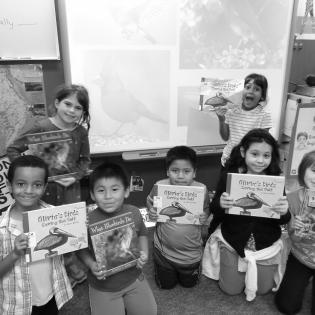Giving Cheer
The children brainstorm ways to give and share to bring cheer to someone.
The learner will:
- identify ways they can use their time and talent to make a positive change.
- create greeting cards of appreciation and/or cheer for someone who needs support.
read-aloud copy of Seeds of Change by Jen Cullerton Johnson and this Learning to Give literature guide.
- service: to provide a community or organization with something that it needs
- donate: to give or present something, especially to a charitable organization or other good cause
- appreciate: to recognize and like the qualities in somebody or something
Instructions
Anticipatory Set:
Brainstorm some things that trees give us (oxygen, forests to walk in, shade, beautiful leaves, maple syrup, acorns, wood, apples, homes for animals). Ask what we give trees. Nature is a beautiful model of generosity. The generosity comes back to them when we give them carbon dioxide, care, respect, forest management, and nourishment for the soil. Philanthropy is something generous we do, and it comes back to us in the forms of happiness, relationships, healthy communities, and much more.
Read aloud the book Seeds of Change by Jen Cullerton Johnson and use this literature guide to facilitate discussion and activities.
Brainstorm ways we can take action to give back to trees to keep them as healthy as they keep us. What positive things can we do for trees with our time, talent, voice, and attention?
Brainstorm ways to show gratitude and generosity to people in our community who would benefit from kindness because they are good to us or because they need support. For example, they may choose to write cheerful cards to family members, grandparents who aren't feeling well, or people such as the school's cafeteria workers, police officers, senior citizens, children in hospitals, or people serving in the armed forces.
Brainstorm and write in a display area words or phrases that are appropriate to the recipients and that will convey appreciation and/or cheer. For example: "Bringing Sunshine Your Way!" or "I Appreciate You!" or "You Make Me Smile!"
Children may use markers, crayons, or colored pencils to decorate cards and write a message inside. They deliver the cards in person or in the mail, depending on their relationship with the recipient.
Philanthropy Framework
-
Strand PHIL.I Definitions of Philanthropy
-
Standard DP 02. Roles of Government, Business, and Philanthropy
-
Benchmark E.6 Explain why acting philanthropically is good for the community, state, nation, or world.
-
-
-
Strand PHIL.III Philanthropy and the Individual
-
Standard PI 01. Reasons for Individual Philanthropy
-
Benchmark E.1 Describe one reason why a person might give or volunteer.
-
-
-
Strand PHIL.IV Volunteering and Service
-
Standard VS 01. Needs Assessment
-
Benchmark E.1 Identify a need in the school, local community, state, nation, or world.
-
-
Standard VS 03. Providing Service
-
Benchmark E.1 Provide a needed service.
-
-
Standard VS 05. Integrating the Service Experience into Learning
-
Benchmark E.3 Identify outcomes from the service.
-
-
